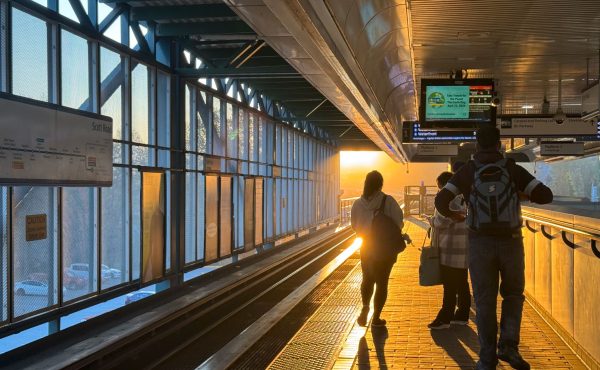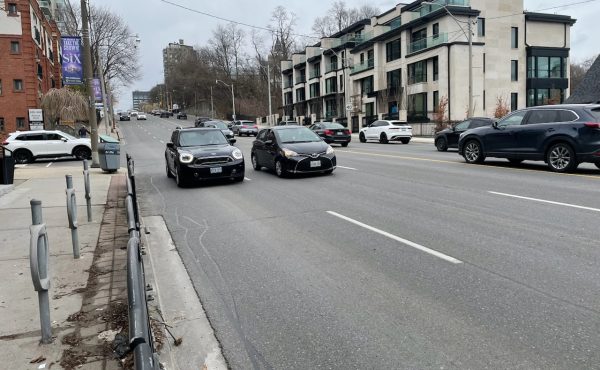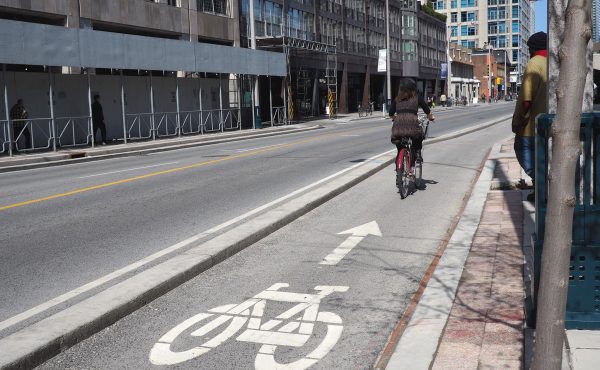At his Transportation Policy Launch / $250-a-plate fundraiser on Friday, George Smitherman delivered a 3251-word speech. (I’m going by his official “speaking notes,” to which he stuck very, very close.) After 1059 words of introduction, he addressed the following topics, in order:
• Expansion of public transit (including a broadly-sketched financial rationale): 1383 words
• Cycling policies: 170 words
• Vehicle registration tax and disruptions to motorists: 80 words
• Limited free TTC rides for seniors: 85 words
Not necessarily an unreasonable ratio, but enough to make clear that everything other than public transit is an afterthought in the context of Smitherman’s “Integrated Transportation Plan.” (The “backgrounder” distributed to media — and posted online here — is actually more interesting than the speech itself, and also has a section concerning what Smitherman would do for pedestrians.)
John Lorinc, Steve Munro, and just about everyone else (including me!) have already written extensively about the transit stuff, so let’s now take a look at the 170 words about cycling initiatives:
“As an advocate of an integrated transportation approach, I believe we must also introduce a coordinated roads policy – including a balanced cycling policy.”
This earned some applause from the 1200-person audience. Not as much as his earlier statement that “My Transit Delivered Plan does not depend on road tolls or congestion charges of any form,” but an encouraging amount nonetheless.
“What greater indication can there be of City Hall’s leadership failures than to realize that Toronto can be distracted so deeply by a debate about where to put bike lanes? It drives me up the wall.”
Good, good. If I hadn’t been furiously tweeting, I would have been nodding in approval.
“So here’s what I will do. If I am elected Mayor, there will be an immediate adjustment in our cycling priorities. We will take a time out on new bike lanes but we will move swiftly to ensure that current cycling routes are made safer and are better maintained.”
No applause for this one. Even before a crowd that’s far better healed than the average person, proclaiming a moratorium on new bike lanes — even if it means rededicating resources to current lanes — does not seem to be a popular position. There’s no doubt that many roads are in terrible condition and that cyclists suffer from this at least as much as motorists do, but this is just a convenient excuse to avoid the sadly divisive debates about new lanes. Sidestepping the subject is a different kind of “leadership failure.”
Sherbourne’s patchy paving, for example, makes it a brutal street to ride on, despite its bike lanes. This is a key reason I’m grateful that accommodations for cyclists are being integrated into the reconstruction of Jarvis, three blocks over. Painting new lanes and improving the conditions of existing ones are hardly mutually exclusive strategies and priorities. While there’s something to be said for a “quality over quantity” argument, such “quality” is more about filling in and completing the current network than it is just about simple upkeep.
“Moving forward, we will focus on curbing bike lanes to create physical separation of cycling areas from drivers.”
Much cheering! Impressive! I wonder if the people in attendance were similarly enthusiastic about the City’s University Avenue proposal. Oh, but! Smitherman clarified in the press conference afterward that these curbed bike lanes would not be new ones but rather existing lanes to which a curb would be added. So presumably no University Ave. Asked by several reporters to cite examples of current lanes where this modification might be appropriate, Smitherman failed to name a single one. And Steve Munro pointed out the “duh” factor: curbing many, if not most, existing lanes would significantly screw over street parking. Maybe that’s not such a bad thing (we could all stand to be doored less), but no real consideration has been given to the fact that this would not be any more politically “safe” than building new lanes.
There’d be no new money for this, either. The cash would come from the current capital budget set aside for constructing bike lanes.
“We will expedite the expansion of dedicated bike paths with an emphasis on so-called ‘expressways’ through parks, ravines and hydro-corridors. We will urge strict enforcement of traffic laws. And we will improve opportunities for our kids to learn bicycle safety and the rules of the road.”
Well, more power to you, I suppose. And more power would be needed, as the City of Toronto is — for better and worse — legally prohibited from giving direction to the Toronto Police as to how they should or shouldn’t go about enforcing the law. They can nag them, sure, and sometimes it helps, but it’s unclear exactly what it means when a candidate promises he will “urge” the police to do something they should probably be doing anyway. Similarly, Toronto Hydro isn’t all that keen on loaning out its corridors, though the City likely has a bit more room to negotiate with them than they do with the police.
As for the “expressways” through parks and ravines, well, I anxiously await a map. Hopefully it will be more concretely plausible than the one Smitherman drafted for transit.
Photo from the Waterfront Toronto Flickr stream, with the other stuff added by moi.





21 comments
Of the three politicians featured in this photo, only David Miller seems to have his bike seat at the correct height, extending his legs to the correct angle when the pedals are in the 6 & 12 position and reducing stress on the knees and quads. A moot point some might say, but perhaps a poorly adjusted bike seat is a sign of a poorly adjusted cycling policy? 🙂
I had the exact same reaction to that photo! And properly extended legs also look a lot more flattering for photo op purposes.
Not to mention Smithy and Flaherty’s dad shorts. Oh wait. I just mentioned them.
I wonder how it will compare to this plan, which seems to be something that the City is already moving toward doing this year.
How would the curbs be built? Would the bike lanes be at road level with a very narrow raised concrete section separating them from the traffic lanes, or would the bike lanes be elevated somewhat? The reason I ask is that one of the factors complicating the Bloor Street makeover was that the City had to lower the pavement to maintain curb height (the road slopes down toward the curb for drainage, so if you widen the sidewalk, it means the curb height will decrease).
A lot of the bike lanes that have been accommodated have been easy wins (politics aside) because they didn’t require much construction — in most cases, just removing the existing paint and putting new paint down.
Seems like he has the right idea, generally, but some of the execution may not be ideal. But there is always a tradeoff (ie curbed lanes vs curbside parking), especially in an economy where there is little money to be spent on any of these improvements.
I appreciate the article, thanks. As a general comment I would tend to say curbs schmurbs, now isn’t the time for this discussion. In case anyone’s forgotten, the man that truly did support cycling as much as reasonably possible has practically been run out of the village for his sins. Whomever you get in return is going to be less proactive, that’s a given, and if there’s one thing you can take with a grain of salt, it’s electioneering mumbo-jumbo. Let’s get back to this subject after the election, when it’s time to walk the walk.Then we’ll see what’s truly possible, whether it be curbs, subways, or pie in the sky.
If bike lanes are curbed, how will the snow be plowed in the winter? You would need two snow plows: one to push the snow off the vehicle lane (into the bike lane) and another plow right behind it to push the snow out of the bike lane. I’m sure this will have budget impacts.
I’m pleased to see mention of curbs for existing bikelanes.
If Smitherman needs an example I’d cite the eastbound Gerrard St. bike lane at Yonge.
Almost every day features at least 3 – 4 cars parked just east of Yonge as drivers run in for a snack or a smoke or to pickup or drop-off at the Ryerson campus.
The road width is giant for the two single lanes and would easily accomodate a road divider a la Montreal.
Speaking of which, when is someone going to do a feature comparing urban solutions in dense cities visually. I hear about Montreal, New York, etc but I’d love to see some photos.
Thanks
I like the idea of separated bike lanes – like the MGT – but just putting a curb on an existing lane doesn’t seem practical. Most bike lanes in Toronto are relatively narrow – I often ride outside the lane when there’s debris, potholes, or if I’m passing a slower cyclist. Slapping a curb on top of the line won’t leave much room for maneuvering or passing.
At the risk of being excessively cynical, I think the applause for Smitherman’s line about “curbing bike lanes” may have had to do with a collective misinterpretation about what exactly he meant by the word “curbing.” Certainly there are two possible interpretations. And I suppose we could ask if that was an intentional double-entendre, or just a happy coincidence…
I agree with Ryan. I think putting curbs on bike lanes would be more restricting than anything else, and even less safe as it creates yet another obstacle for cyclists to worry about. Bike lanes as they’re currently done seem to me good enough (with the exception of Sherbourne, which is in such bad shape it’s less convenient than even the bike lane-less Jarvis). I’d rather see a continued emphasis on more bike lanes, but in a way that actually integrates them into one network, instead of just a few spotty lines here and there. Those ‘expressways’ sound all well and good too, but it seems to me that (unlike cars) most cyclists don’t commute from far enough distances to need their own 400-series highways to bypass city streets. It’s access to those city streets that makes cycling so convenient.
All this talk about “what about the snow?” and “what about parking?” and “what about drainage?” is making the Spacing folks sound like a bunch of grumpy old men. I remember when Spacing would respond to stuff like this with a photo from Amsterdam or Portland showing exactly how such a proposal can and does work. This “can’t-do” crap is exactly why we don’t have a decent bike network in this City.
And yes, John L., I think you are being excessively cynical. “We will move swiftly to ensure that current cycling routes are made safer and are better maintained […] we will focus on curbing bike lanes to create physical separation of cycling areas from drivers.” That seems pretty clear to me, unless your other meaning of “curb” refers to picking up dog poop.
John 5:12PM> Note our comment disclaimer: “Neither the author nor Spacing necessarily agree with the comments posted below.” 🙂
Though I agree – “can’t do” – constantly fighting that, it creeps in all over.
I hope that these curbed bike lanes will be between the parking lane and the sidewalk. If that is what he intends, it could be a real step forward (even though I do worry he is trying to pacify the bicycling community while doing nothing on new bike lanes).
In Montreal each direction of the curbed bike lanes are placed together on one side of the road. If you’re behind slower cyclists you wait until there is no one approaching in the opposite direction then use that lane to pass, the same way cars pass slower vehicles on two lane rural highways, or the same way as a cyclist you would pass other cyclists on most of our recreational trails. Placing them together on one side of the road should also make construction and maintenance less costly.
Curbed lanes are probably frustrating for many fast experienced cyclists, and therefore they might choose other routes, but the lanes will make cycling much more accessible for many people who now feel city cycling is too dangerous, and should pull some of those who now ride on sidewalks back onto the road where they belong.
Is this an okay place to express sincere thanks to anyone who had anything to do with making the west end railpath a reality? Just tried it out this evening and it is heaven. What a pleasure to pedal along a smooth surface uninterrupted by stop signs, lights and safe from traffic.
Any candidates supporting its extension?
Agree with Ryan and Martin, at current width, putting a curb to separate bike lane from car lane will be limiting and dangerous. Plus think about how many more door prize we will get, a car just pull over next to the curb and the passenger door opens, BANG! To prevent that you will need a rather wide median. Now, how many streets in Toronto can accommodate a wider-bike-lane plus the median combo?
If we want to go ahead and create physically separated bikelanes, I would suggest bi-directional bikelanes on one side of street (make it north-side in EW street to take advantage of winter sun light). Thus it does not have to be as wide as two uni-directional bikelane combined, while still have rooms for passing, evading obstruction, etc. Plus it will only require one median, and even with narrower median, the bike will travel facing a car parked next to the curb, greatly reducing the chance of door-prize. As for snow removal, I don’t think it is going to be a big problem. The plow for sidewalk is perfectly capable of handling bike lanes.
The New and Improved Karen (“bags, bottles, & bicycles”) Stintz writing in the Post: “While I will not join the ranks of the daily bike commuter, I will bike to work more regularly. I have also learned a few things. I felt safer when riding on dedicated bike lanes. I have a new appreciation for the complaint about people parking in bike lanes. Biking on secondary roads is less appealing because there are so many stop signs. I am not sure we have a rational plan for integrating bike lanes into our transportation network but I do believe we should keep trying.”
http://news.nationalpost.com/2010/06/01/urban-scrawl-karen-stintz-how-i-caught-the-cycling-bug/
Also, her bike seat appears to be adjusted properly, and she looks great in definitely-not-dad-shorts.
Maybe I’m naive, but I sense real opportunities opening up for cyclists during this election, as long as we don’t punish the newbies with snarky responses to promising, if incomplete, proposals.
Thanks for this monitoring of important policy.
Bike are the future – for many of us, though some riders aren’t respectful, and I’m glad it was others being thought of as grumpy older men…
The bulk of the cyclists are in the older core of downtown, and the bulk of the crashes also tend to be downtown – so if there was a concern about public health along with reining in greenhouse gas emissions, that’s where the focus would be.
I think we’ve been taking some wrong turns with how and where we do bike lanes including a weak and tepid Bike Plan – and have much less regard for Mr. Miller’s legacy than others eg. the travesty of Bloor in Yorkvile, which is wasting the opportunity for easy bike lanes in the wasting of space between new curb and planter.
It’s also been over four years since we first had an announcement of a Bloor bike lane study, and now we are selecting a consultant to help with the analysis paralysis till after the election, even though better biking parallel to the subway could essentially expand the subway for the price of paint (the cost of a road-restriping for a bike lane is $25,000/km – and at times I wonder why there aren’t more bike lanes?)
And the dominant travel and injury mode for cyclists is on the east-west str4eets and they don’t count streetcar track crashes. Putting more lanes through parks etc. doesn’t help most of us in the core.
I think Jarvis is only two short blocks away from Sherbourne, which may be repaved next year, perhaps with a two-in-one bike lane.
I tend to agree with John Lorinc about the “curbing” of bike lanes being a deliberate mis-leading.
All-in-all cause for worry about Smitherman et all, and hope for a smoggy hot summer to highlight Caronto’s transport emissions.
If you need guidance on how to design physically-protected bike lanes on a tight budget with standard North American sweeping and snow plowing, look no further than NYC. We’ve been installing them since 2007, without removing much parking, and often with added ped refuges to benefit pedestrians. We have 9.4 miles of protected bike lanes in place right now, and we will have 12.4 additional miles by the end of 2010.
The link is to the NYC standard design manual. Page 7 has two typical types of facilities, both of which rely on parked cars to provide the physical separation for bikes, and both use paint and some plastic posts to direct the cars where to park. Both are fully able to be plowed and cleaned without new equipment. Enjoy!